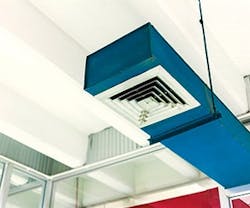Required by energy code in many parts of the country, fresh outdoor air offers a multitude of benefits for building occupants, from avoiding sick building syndrome to equalizing building pressure.
Energy recovery ventilators (ERVs) are a popular choice for fresh air ventilation, as they allow users to precondition the temperature and humidity of outdoor air using the waste energy from building exhaust. Not only does the fresh air and consistent temperature improve IEQ, the use of exhaust for conditioning reduces the mechanical heating and cooling load to save energy and money.
Your occupants could likely benefit from a breath of fresh air – but is an ERV the way to accomplish that? Evaluate this technology for your facility below.
Find Your Best Fit
Typically built into rooftop air handlers or ventilation systems, energy recovery ventilators (ERVs) transfer heat between counterflowing streams of fresh air and exhaust air, which are separated by partitions within the device. Depending on your climate, your facility may be better served by a heat wheel, which cools outside air in the summer and heats it in the winter, or a total energy recovery unit, which transfers both heat and humidity using a desiccant media that can adsorb and release molecules. Either can save roughly 80% of outdoor air-related energy costs by repurposing energy from building exhaust, notes Randall Steele, vice president and general manager of Airxchange. However, it’s important to understand your area’s climate to determine which is the best fit.
The technology also helps expel indoor air pollutants, an important step in maintaining good IAQ.
“Indoor air can be two to five times more polluted than outdoor air, according to the EPA, but most people think of outdoor air pollution as the biggest concern,” Steele explains. “When you seal a building tightly and trap air inside, you can get buildup of airborne viruses and bacteria, VOCs like formaldehyde or fire retardants, cleaning fluids, and more.”
Using an ERV with a dedicated outdoor system further contributes to efficiency by allowing you to downsize the compressor, says Edouard Ferrier, applications engineer at LG Electronics. This means less energy is needed for conditioning, leading to greater energy savings. Ferrier also recommends pairing ERVs with filters that have high MERV (Minimum Efficiency Reporting Values) ratings to mitigate outdoor pollutants.
TLC for ERVs
Have your system cleaned at least two to four times a year to make sure your ERV doesn’t lose efficiency, recommends Greg Day, applications engineer at LG Electronics. This will allow you to catch potential problems early before they can grow. This is particularly important if you have a wheel-type unit, which has more moving parts than fixed-plate devices. Broken parts on wheels can lead to the unit only balancing heat instead of also tackling humiditiy.
“I see issues arise when the simplest things could have been avoided, such as the wheels getting clogged up or growing bacteria and mold,” Day explains. “The energy recovery wheel requires a belt and motor to turn the wheel to constantly mix the air, so clogging is most likely due to poor cleaning maintenance.”
The routine should include a visual inspection of the wheel or plate surface, as well as the fresh air and exhaust filters, Steele adds. Conduct the inspection whenever you change the filters.
“A lot of FMs will monitor the need to clean by measuring the pressure drop across the filters and wheels, which gives you an indication that airflow may be inhibited,” says Steele. “Inspect any moving parts and clean the heat transfer surface as needed. Some manufacturers will offer rotation sensors, which are an inexpensive way to make sure the wheels are turning.”
Janelle Penny [email protected] is senior editor of BUILDINGS.
About the Author
Janelle Penny
Editor-in-Chief at BUILDINGS
Janelle Penny has been with BUILDINGS since 2010. She is a two-time FOLIO: Eddie award winner who aims to deliver practical, actionable content for building owners and facilities professionals.

